ECONOMICS FOR BUSINESS 2: Reforms in Education Industry in Australia
VerifiedAdded on 2020/03/01
|8
|1543
|52
Report
AI Summary
This report examines the economic impacts of recent higher education reforms in Australia. The analysis focuses on changes to student fees, government funding cuts, and alterations to student loan repayment schemes. It explores how these reforms affect the demand for education, particularly among international students, and discusses the implications for the Australian economy. The report applies economic principles like supply and demand to illustrate the effects of price hikes on student enrollment and revenue generation. Furthermore, it considers the potential for increased competition from other countries' higher education sectors and suggests measures the Australian government could take to mitigate negative impacts and maintain the attractiveness of its education system. The report uses figures and diagrams to explain the concepts and provides references to support the analysis.
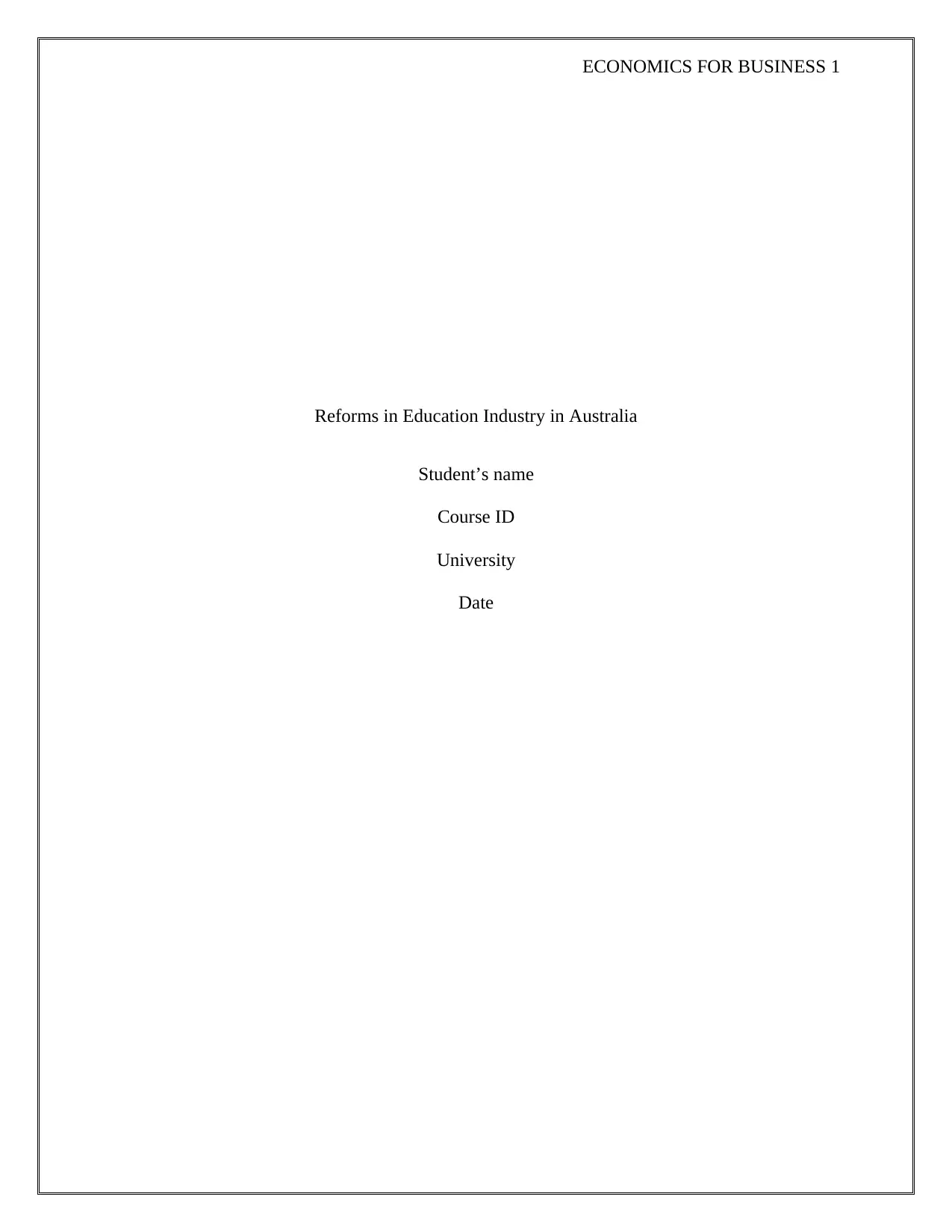
ECONOMICS FOR BUSINESS 1
Reforms in Education Industry in Australia
Student’s name
Course ID
University
Date
Reforms in Education Industry in Australia
Student’s name
Course ID
University
Date
Paraphrase This Document
Need a fresh take? Get an instant paraphrase of this document with our AI Paraphraser
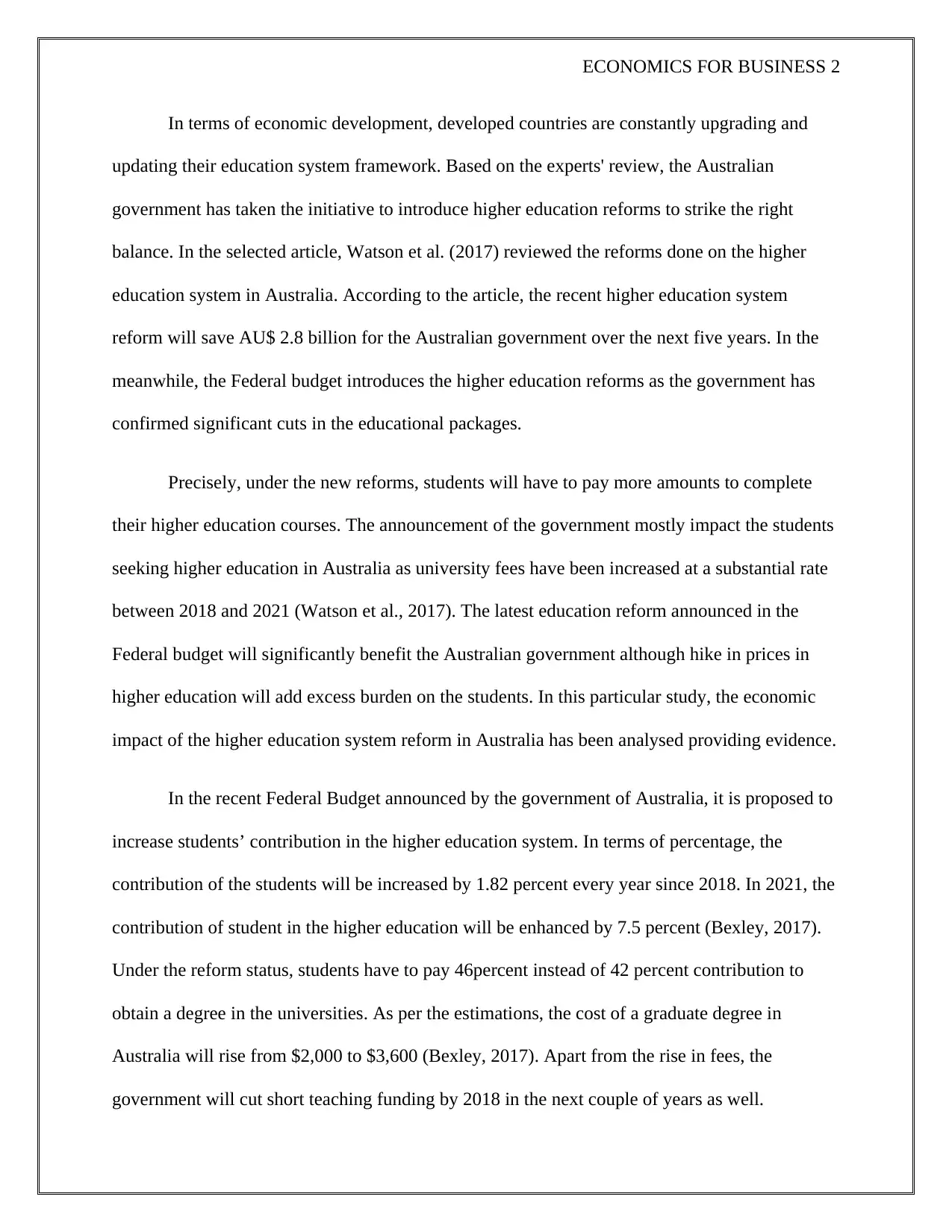
ECONOMICS FOR BUSINESS 2
In terms of economic development, developed countries are constantly upgrading and
updating their education system framework. Based on the experts' review, the Australian
government has taken the initiative to introduce higher education reforms to strike the right
balance. In the selected article, Watson et al. (2017) reviewed the reforms done on the higher
education system in Australia. According to the article, the recent higher education system
reform will save AU$ 2.8 billion for the Australian government over the next five years. In the
meanwhile, the Federal budget introduces the higher education reforms as the government has
confirmed significant cuts in the educational packages.
Precisely, under the new reforms, students will have to pay more amounts to complete
their higher education courses. The announcement of the government mostly impact the students
seeking higher education in Australia as university fees have been increased at a substantial rate
between 2018 and 2021 (Watson et al., 2017). The latest education reform announced in the
Federal budget will significantly benefit the Australian government although hike in prices in
higher education will add excess burden on the students. In this particular study, the economic
impact of the higher education system reform in Australia has been analysed providing evidence.
In the recent Federal Budget announced by the government of Australia, it is proposed to
increase students’ contribution in the higher education system. In terms of percentage, the
contribution of the students will be increased by 1.82 percent every year since 2018. In 2021, the
contribution of student in the higher education will be enhanced by 7.5 percent (Bexley, 2017).
Under the reform status, students have to pay 46percent instead of 42 percent contribution to
obtain a degree in the universities. As per the estimations, the cost of a graduate degree in
Australia will rise from $2,000 to $3,600 (Bexley, 2017). Apart from the rise in fees, the
government will cut short teaching funding by 2018 in the next couple of years as well.
In terms of economic development, developed countries are constantly upgrading and
updating their education system framework. Based on the experts' review, the Australian
government has taken the initiative to introduce higher education reforms to strike the right
balance. In the selected article, Watson et al. (2017) reviewed the reforms done on the higher
education system in Australia. According to the article, the recent higher education system
reform will save AU$ 2.8 billion for the Australian government over the next five years. In the
meanwhile, the Federal budget introduces the higher education reforms as the government has
confirmed significant cuts in the educational packages.
Precisely, under the new reforms, students will have to pay more amounts to complete
their higher education courses. The announcement of the government mostly impact the students
seeking higher education in Australia as university fees have been increased at a substantial rate
between 2018 and 2021 (Watson et al., 2017). The latest education reform announced in the
Federal budget will significantly benefit the Australian government although hike in prices in
higher education will add excess burden on the students. In this particular study, the economic
impact of the higher education system reform in Australia has been analysed providing evidence.
In the recent Federal Budget announced by the government of Australia, it is proposed to
increase students’ contribution in the higher education system. In terms of percentage, the
contribution of the students will be increased by 1.82 percent every year since 2018. In 2021, the
contribution of student in the higher education will be enhanced by 7.5 percent (Bexley, 2017).
Under the reform status, students have to pay 46percent instead of 42 percent contribution to
obtain a degree in the universities. As per the estimations, the cost of a graduate degree in
Australia will rise from $2,000 to $3,600 (Bexley, 2017). Apart from the rise in fees, the
government will cut short teaching funding by 2018 in the next couple of years as well.
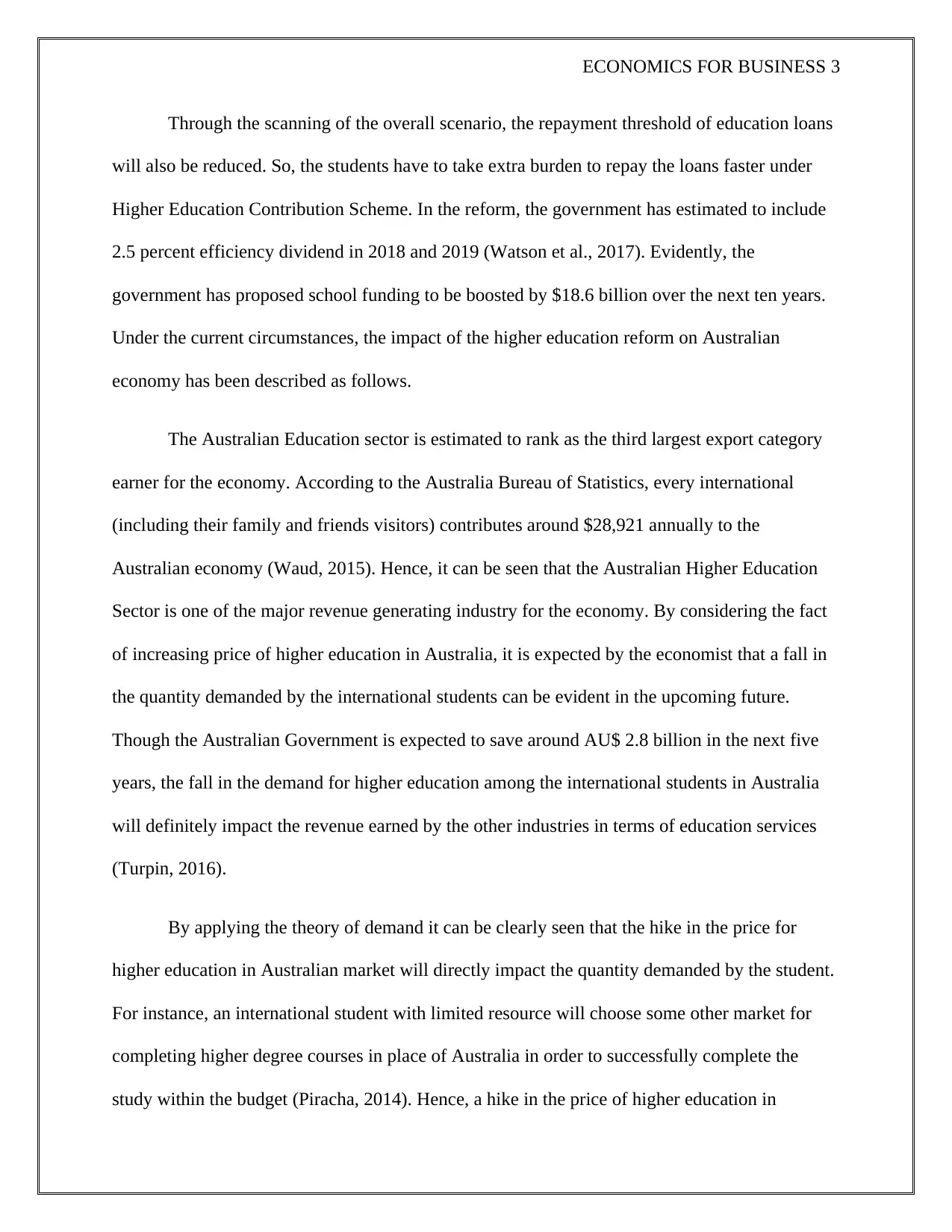
ECONOMICS FOR BUSINESS 3
Through the scanning of the overall scenario, the repayment threshold of education loans
will also be reduced. So, the students have to take extra burden to repay the loans faster under
Higher Education Contribution Scheme. In the reform, the government has estimated to include
2.5 percent efficiency dividend in 2018 and 2019 (Watson et al., 2017). Evidently, the
government has proposed school funding to be boosted by $18.6 billion over the next ten years.
Under the current circumstances, the impact of the higher education reform on Australian
economy has been described as follows.
The Australian Education sector is estimated to rank as the third largest export category
earner for the economy. According to the Australia Bureau of Statistics, every international
(including their family and friends visitors) contributes around $28,921 annually to the
Australian economy (Waud, 2015). Hence, it can be seen that the Australian Higher Education
Sector is one of the major revenue generating industry for the economy. By considering the fact
of increasing price of higher education in Australia, it is expected by the economist that a fall in
the quantity demanded by the international students can be evident in the upcoming future.
Though the Australian Government is expected to save around AU$ 2.8 billion in the next five
years, the fall in the demand for higher education among the international students in Australia
will definitely impact the revenue earned by the other industries in terms of education services
(Turpin, 2016).
By applying the theory of demand it can be clearly seen that the hike in the price for
higher education in Australian market will directly impact the quantity demanded by the student.
For instance, an international student with limited resource will choose some other market for
completing higher degree courses in place of Australia in order to successfully complete the
study within the budget (Piracha, 2014). Hence, a hike in the price of higher education in
Through the scanning of the overall scenario, the repayment threshold of education loans
will also be reduced. So, the students have to take extra burden to repay the loans faster under
Higher Education Contribution Scheme. In the reform, the government has estimated to include
2.5 percent efficiency dividend in 2018 and 2019 (Watson et al., 2017). Evidently, the
government has proposed school funding to be boosted by $18.6 billion over the next ten years.
Under the current circumstances, the impact of the higher education reform on Australian
economy has been described as follows.
The Australian Education sector is estimated to rank as the third largest export category
earner for the economy. According to the Australia Bureau of Statistics, every international
(including their family and friends visitors) contributes around $28,921 annually to the
Australian economy (Waud, 2015). Hence, it can be seen that the Australian Higher Education
Sector is one of the major revenue generating industry for the economy. By considering the fact
of increasing price of higher education in Australia, it is expected by the economist that a fall in
the quantity demanded by the international students can be evident in the upcoming future.
Though the Australian Government is expected to save around AU$ 2.8 billion in the next five
years, the fall in the demand for higher education among the international students in Australia
will definitely impact the revenue earned by the other industries in terms of education services
(Turpin, 2016).
By applying the theory of demand it can be clearly seen that the hike in the price for
higher education in Australian market will directly impact the quantity demanded by the student.
For instance, an international student with limited resource will choose some other market for
completing higher degree courses in place of Australia in order to successfully complete the
study within the budget (Piracha, 2014). Hence, a hike in the price of higher education in
⊘ This is a preview!⊘
Do you want full access?
Subscribe today to unlock all pages.

Trusted by 1+ million students worldwide
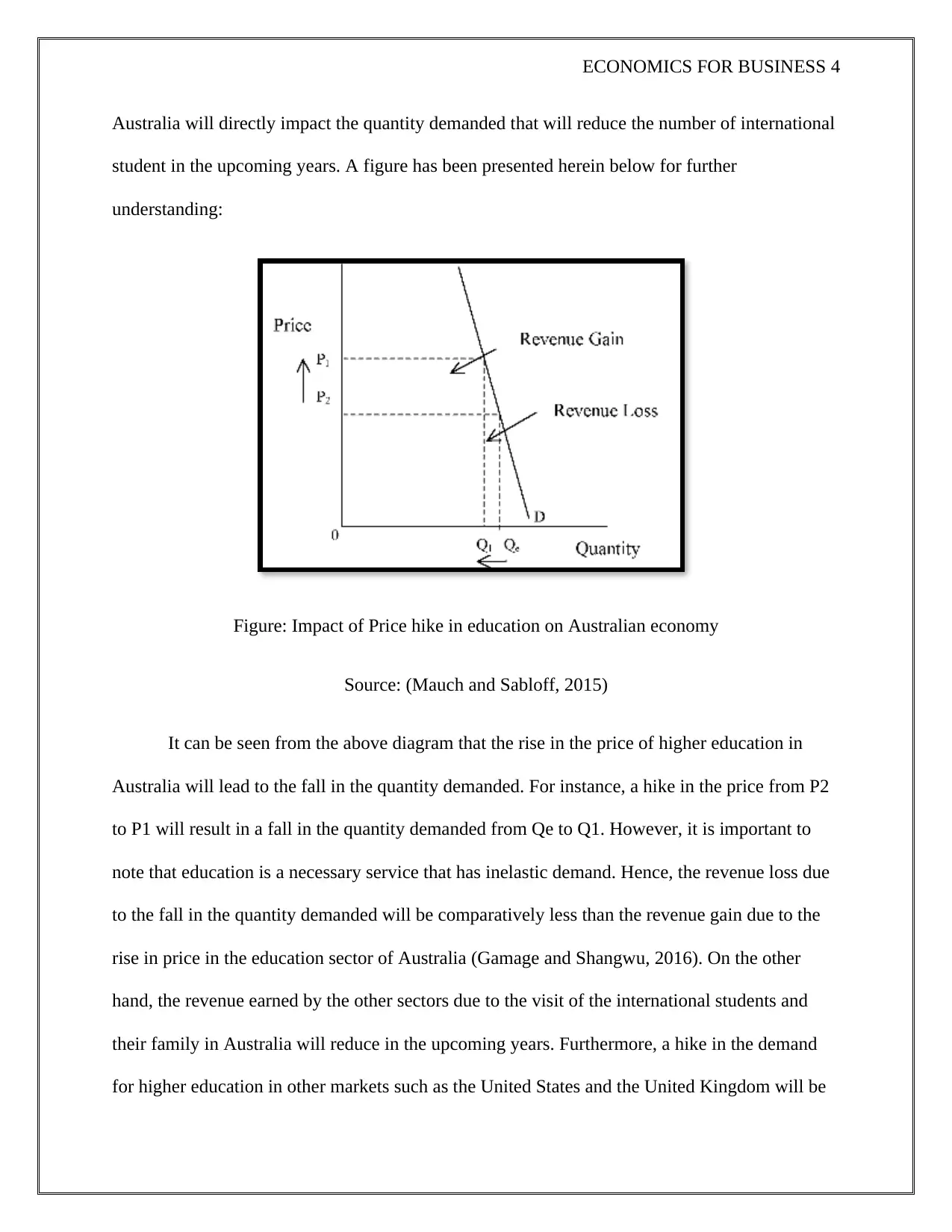
ECONOMICS FOR BUSINESS 4
Australia will directly impact the quantity demanded that will reduce the number of international
student in the upcoming years. A figure has been presented herein below for further
understanding:
Figure: Impact of Price hike in education on Australian economy
Source: (Mauch and Sabloff, 2015)
It can be seen from the above diagram that the rise in the price of higher education in
Australia will lead to the fall in the quantity demanded. For instance, a hike in the price from P2
to P1 will result in a fall in the quantity demanded from Qe to Q1. However, it is important to
note that education is a necessary service that has inelastic demand. Hence, the revenue loss due
to the fall in the quantity demanded will be comparatively less than the revenue gain due to the
rise in price in the education sector of Australia (Gamage and Shangwu, 2016). On the other
hand, the revenue earned by the other sectors due to the visit of the international students and
their family in Australia will reduce in the upcoming years. Furthermore, a hike in the demand
for higher education in other markets such as the United States and the United Kingdom will be
Australia will directly impact the quantity demanded that will reduce the number of international
student in the upcoming years. A figure has been presented herein below for further
understanding:
Figure: Impact of Price hike in education on Australian economy
Source: (Mauch and Sabloff, 2015)
It can be seen from the above diagram that the rise in the price of higher education in
Australia will lead to the fall in the quantity demanded. For instance, a hike in the price from P2
to P1 will result in a fall in the quantity demanded from Qe to Q1. However, it is important to
note that education is a necessary service that has inelastic demand. Hence, the revenue loss due
to the fall in the quantity demanded will be comparatively less than the revenue gain due to the
rise in price in the education sector of Australia (Gamage and Shangwu, 2016). On the other
hand, the revenue earned by the other sectors due to the visit of the international students and
their family in Australia will reduce in the upcoming years. Furthermore, a hike in the demand
for higher education in other markets such as the United States and the United Kingdom will be
Paraphrase This Document
Need a fresh take? Get an instant paraphrase of this document with our AI Paraphraser
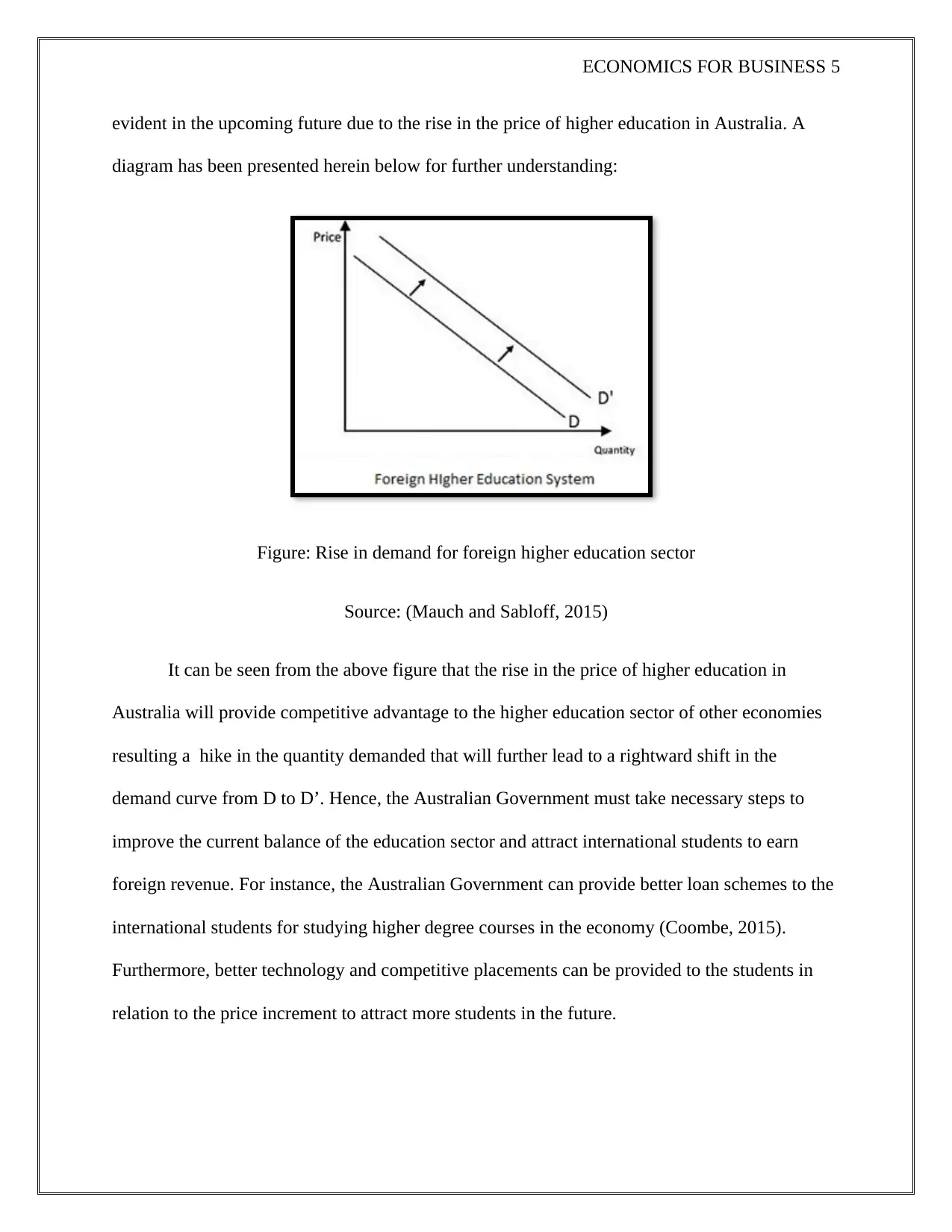
ECONOMICS FOR BUSINESS 5
evident in the upcoming future due to the rise in the price of higher education in Australia. A
diagram has been presented herein below for further understanding:
Figure: Rise in demand for foreign higher education sector
Source: (Mauch and Sabloff, 2015)
It can be seen from the above figure that the rise in the price of higher education in
Australia will provide competitive advantage to the higher education sector of other economies
resulting a hike in the quantity demanded that will further lead to a rightward shift in the
demand curve from D to D’. Hence, the Australian Government must take necessary steps to
improve the current balance of the education sector and attract international students to earn
foreign revenue. For instance, the Australian Government can provide better loan schemes to the
international students for studying higher degree courses in the economy (Coombe, 2015).
Furthermore, better technology and competitive placements can be provided to the students in
relation to the price increment to attract more students in the future.
evident in the upcoming future due to the rise in the price of higher education in Australia. A
diagram has been presented herein below for further understanding:
Figure: Rise in demand for foreign higher education sector
Source: (Mauch and Sabloff, 2015)
It can be seen from the above figure that the rise in the price of higher education in
Australia will provide competitive advantage to the higher education sector of other economies
resulting a hike in the quantity demanded that will further lead to a rightward shift in the
demand curve from D to D’. Hence, the Australian Government must take necessary steps to
improve the current balance of the education sector and attract international students to earn
foreign revenue. For instance, the Australian Government can provide better loan schemes to the
international students for studying higher degree courses in the economy (Coombe, 2015).
Furthermore, better technology and competitive placements can be provided to the students in
relation to the price increment to attract more students in the future.
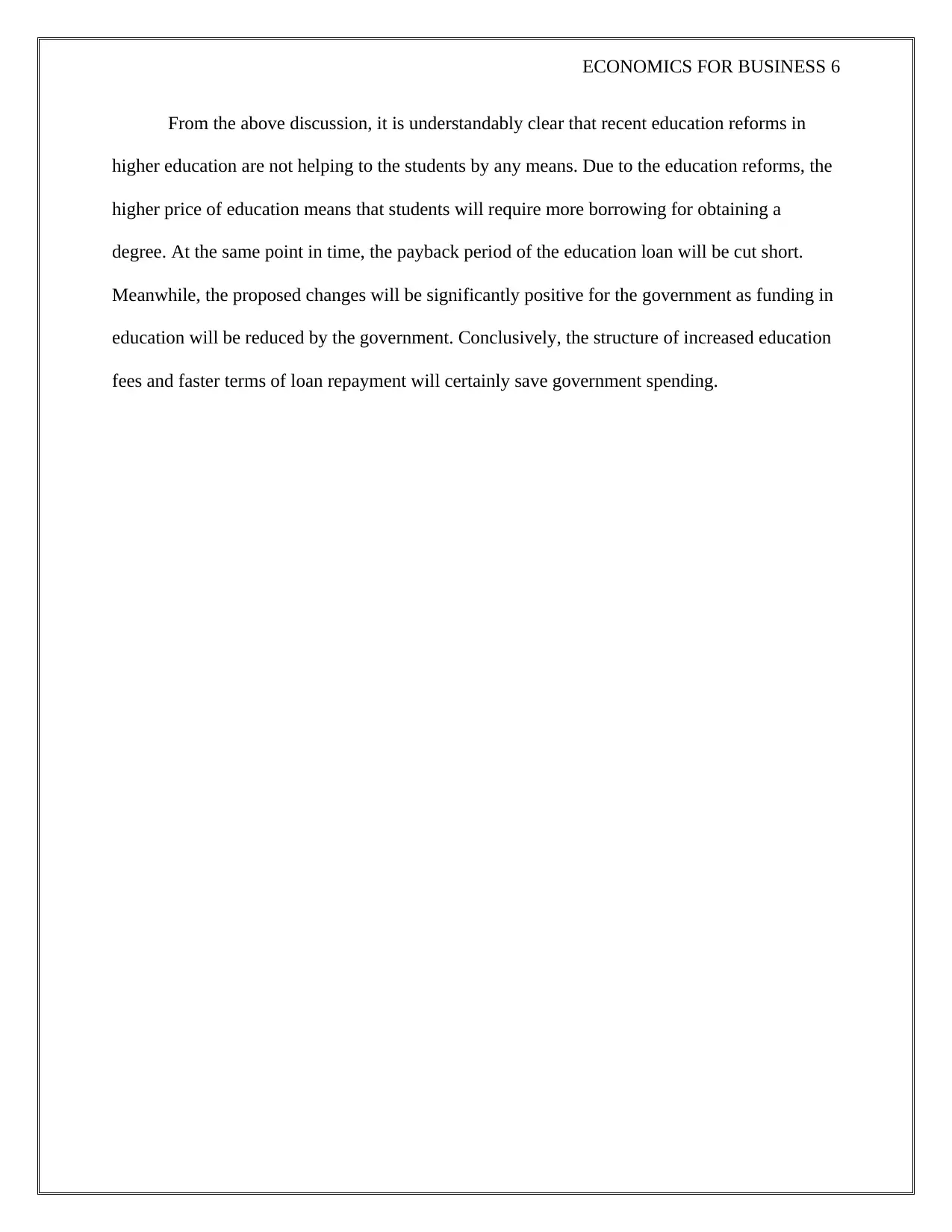
ECONOMICS FOR BUSINESS 6
From the above discussion, it is understandably clear that recent education reforms in
higher education are not helping to the students by any means. Due to the education reforms, the
higher price of education means that students will require more borrowing for obtaining a
degree. At the same point in time, the payback period of the education loan will be cut short.
Meanwhile, the proposed changes will be significantly positive for the government as funding in
education will be reduced by the government. Conclusively, the structure of increased education
fees and faster terms of loan repayment will certainly save government spending.
From the above discussion, it is understandably clear that recent education reforms in
higher education are not helping to the students by any means. Due to the education reforms, the
higher price of education means that students will require more borrowing for obtaining a
degree. At the same point in time, the payback period of the education loan will be cut short.
Meanwhile, the proposed changes will be significantly positive for the government as funding in
education will be reduced by the government. Conclusively, the structure of increased education
fees and faster terms of loan repayment will certainly save government spending.
⊘ This is a preview!⊘
Do you want full access?
Subscribe today to unlock all pages.

Trusted by 1+ million students worldwide
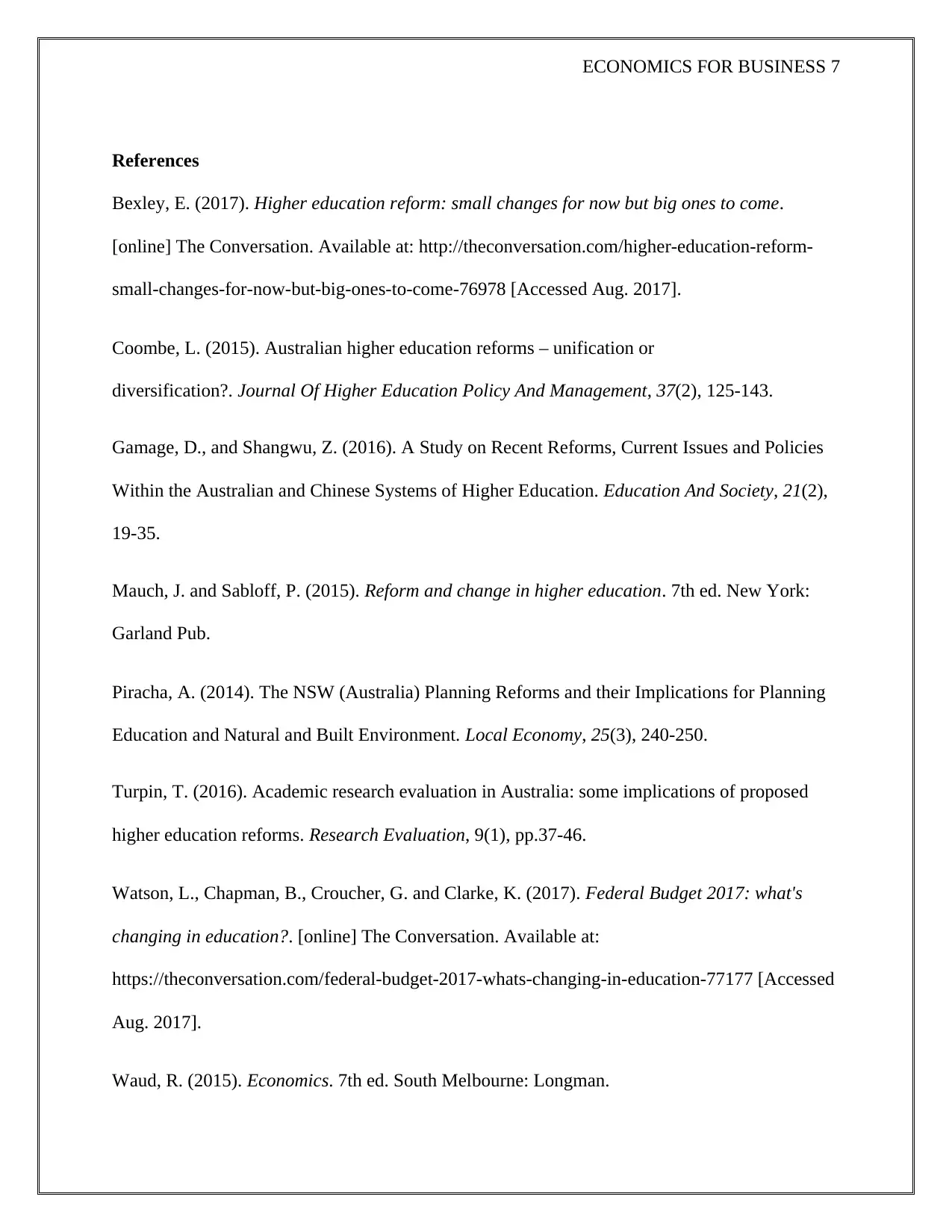
ECONOMICS FOR BUSINESS 7
References
Bexley, E. (2017). Higher education reform: small changes for now but big ones to come.
[online] The Conversation. Available at: http://theconversation.com/higher-education-reform-
small-changes-for-now-but-big-ones-to-come-76978 [Accessed Aug. 2017].
Coombe, L. (2015). Australian higher education reforms – unification or
diversification?. Journal Of Higher Education Policy And Management, 37(2), 125-143.
Gamage, D., and Shangwu, Z. (2016). A Study on Recent Reforms, Current Issues and Policies
Within the Australian and Chinese Systems of Higher Education. Education And Society, 21(2),
19-35.
Mauch, J. and Sabloff, P. (2015). Reform and change in higher education. 7th ed. New York:
Garland Pub.
Piracha, A. (2014). The NSW (Australia) Planning Reforms and their Implications for Planning
Education and Natural and Built Environment. Local Economy, 25(3), 240-250.
Turpin, T. (2016). Academic research evaluation in Australia: some implications of proposed
higher education reforms. Research Evaluation, 9(1), pp.37-46.
Watson, L., Chapman, B., Croucher, G. and Clarke, K. (2017). Federal Budget 2017: what's
changing in education?. [online] The Conversation. Available at:
https://theconversation.com/federal-budget-2017-whats-changing-in-education-77177 [Accessed
Aug. 2017].
Waud, R. (2015). Economics. 7th ed. South Melbourne: Longman.
References
Bexley, E. (2017). Higher education reform: small changes for now but big ones to come.
[online] The Conversation. Available at: http://theconversation.com/higher-education-reform-
small-changes-for-now-but-big-ones-to-come-76978 [Accessed Aug. 2017].
Coombe, L. (2015). Australian higher education reforms – unification or
diversification?. Journal Of Higher Education Policy And Management, 37(2), 125-143.
Gamage, D., and Shangwu, Z. (2016). A Study on Recent Reforms, Current Issues and Policies
Within the Australian and Chinese Systems of Higher Education. Education And Society, 21(2),
19-35.
Mauch, J. and Sabloff, P. (2015). Reform and change in higher education. 7th ed. New York:
Garland Pub.
Piracha, A. (2014). The NSW (Australia) Planning Reforms and their Implications for Planning
Education and Natural and Built Environment. Local Economy, 25(3), 240-250.
Turpin, T. (2016). Academic research evaluation in Australia: some implications of proposed
higher education reforms. Research Evaluation, 9(1), pp.37-46.
Watson, L., Chapman, B., Croucher, G. and Clarke, K. (2017). Federal Budget 2017: what's
changing in education?. [online] The Conversation. Available at:
https://theconversation.com/federal-budget-2017-whats-changing-in-education-77177 [Accessed
Aug. 2017].
Waud, R. (2015). Economics. 7th ed. South Melbourne: Longman.
Paraphrase This Document
Need a fresh take? Get an instant paraphrase of this document with our AI Paraphraser

ECONOMICS FOR BUSINESS 8
1 out of 8
Related Documents
Your All-in-One AI-Powered Toolkit for Academic Success.
+13062052269
info@desklib.com
Available 24*7 on WhatsApp / Email
![[object Object]](/_next/static/media/star-bottom.7253800d.svg)
Unlock your academic potential
Copyright © 2020–2025 A2Z Services. All Rights Reserved. Developed and managed by ZUCOL.





